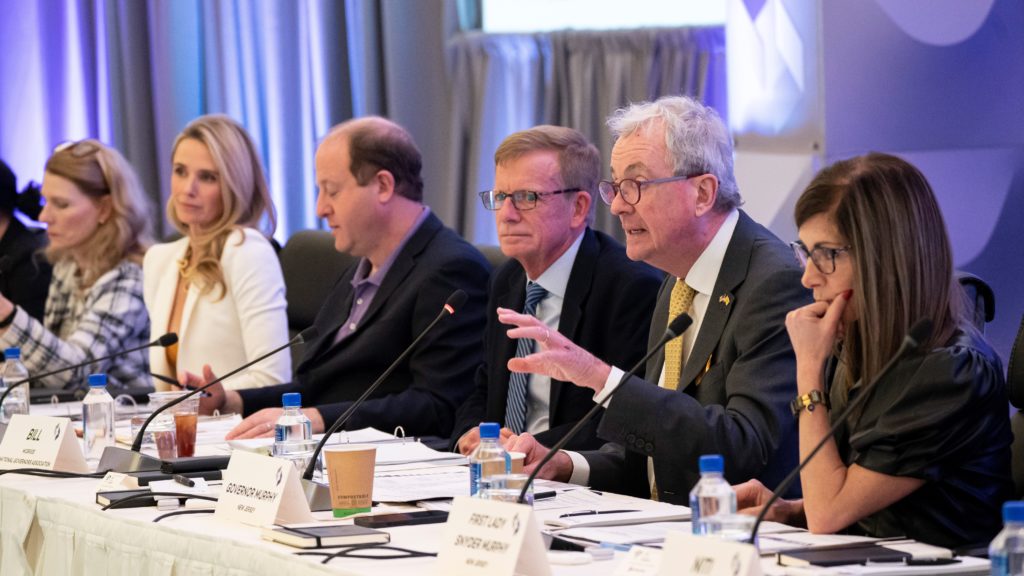Building awareness of youth mental health conditions and understanding sources of and solutions for stigma were the focus of the second convening of NGA Chair Governor Murphy’s Initiative on Strengthening Youth Mental Health.
The second convening of the 2022-2023 NGA Chair’s Initiative: Strengthening Youth Mental Health took place in Santa Monica, California, from January 24 – 25, 2023. This second pillar of the Chair’s Initiative: Increasing Awareness and Reducing Stigma followed the October 2022 convening in Utah on Addressing Prevention and Resilience Building.

NGA Chair New Jersey Governor Phil Murphy was joined by Colorado Governor Jared Polis, First Lady of New Jersey Tammy Snyder Murphy, First Partner of California Jennifer Siebel Newsom, and First Lady of North Carolina Kristin Cooper. Additional state representatives from California, New Jersey, New York, North Carolina, Utah, and West Virginia were present, as well as leaders from academia, community organizations, and the private sector.
Over the two days, roundtable discussions unpacked the Initiative’s second pillar focusing on themes of building a foundation of diversity and equity in addressing stigma, reducing the stigma of mental health and seeking help, and increasing awareness around youth mental health.
Understanding stigma and lack of awareness today
Compared to previous generations, young people today are much more open to talking about mental health and want to play an active role in reducing the stigma surrounding mental health challenges to promote mental wellbeing. Throughout the convening, the young leaders in attendance shared impassioned stories of both their own mental health struggles and the many ways in which youth are organizing to break the stigma. Despite this progress, stigma continues to be a major barrier to young people reaching out for help. Although half of mental health disorders begin by age 14, treatment is often delayed by a decade or more as youth and their families grapple with feelings of fear and shame. Stigma is a reality across different settings: cultural disconnects or generational divides within the home can make it difficult to talk about mental health, and misconceptions continue to pervade attitudes in educational settings, places of worship, and workplaces. Bias, conscious or unconscious, within the healthcare system, can also have a stigmatizing effect on those who need respect, understanding, and support from providers.
This pervasive discrimination drives young people’s silence, as speaking out about mental health issues can have negative consequences if the responses are re-traumatizing and harmful. Far too often, health care professionals and other adults in youth-facing systems show disregard for or misunderstand a young person’s privacy, identity, and agency in making decisions about their wellbeing, care, and treatment. Stigma is not uniform—it manifests differently across communities and demographics and inadequate culturally responsive and representative care contributes to poor mental health outcomes, reinforcing stigma for intersectional populations.
A cloud of misunderstanding around mental health conversations prevents conditions of the brain from being treated the same as conditions of the body. The spectrum of mental health needs to be normalized, with the understanding that supporting good mental health is not an individual’s responsibility, but rather a collective effort that includes community outreach and awareness; provider and caregiver education; safe and supportive school environments; and access to quality, comprehensive, and accessible care. Young people and their families need to be aware of the importance of mental health, feel comfortable talking about it, and know of trusted informational resources to turn to and be able to grow, learn, and receive care in supportive environments that meet their clinical and cultural needs.
How Governors can help: solutions to break the stigma and support the conversation around mental health

Governors can increase awareness and reduce stigma by supporting:
- Existing community-based mental health organizations’ awareness-building efforts: Ensuring funding and other resources get to organizations with deep knowledge of their communities’ mental health challenges
- Targeted anti-stigma campaigns with a focus on storytelling: Developing efforts driven and co-designed by young people, that reach young people on social media, and are focused on diverse populations, including youth of color and Indigenous youth, LGBTQIA+ youth, youth involved in the foster care system, etc. Governors can also humanize mental health by using their platforms to share their personal journeys with mental health
- School mental health curriculums: Growing capacity for mental health literacy for youth and their families by implementing age-appropriate awareness of the spectrum of mental health, bolster mental wellbeing, and encourage youth to seek help, as well as adopting family engagement plans and public-private partnerships to tap into the knowledge and support of thought leaders in the private or nonprofit sector
- Suicide stigma reduction: Normalizing discussing suicide and suicidal ideation, making them less “scary” and unbroachable topics by training youth peers, as well as the adults who live and work with youth, on appropriate and compassionate responses to someone who is experiencing intrusive thoughts can help to reduce the silence around suicide
- Sensitivity training for adults interacting with youth: Enabling sufficient support, care, and treatment for youth experiencing mental health challenges through bias, sensitivity, and cultural responsiveness training for healthcare professionals, educators, and others
- The power of peer networks: Recognizing a recent Active Minds survey that found that 67% of young adults first tell a friend they are feeling suicidal before telling anyone else – supporting the development of a diverse mental health workforce of peer supporters and community health workers to complement a workforce that is able to provide culturally competent care when and where families need it at the level that is needed; including through trainings on mental health identification and crisis management
- Crisis services that meet youth where they are: Protecting young people’s privacy and enabling trust through innovative services such as anonymous text lines or apps and in building youth-specific crisis response systems including home-crisis models
- Delivery systems improvements to promote trust and safety: Addressing the experience patients have when they seek care after breaking the stigma of seeking help, including addressing the trust gap between patients and the health care system
- Increased awareness of people working in programs that support the well-being needs of youth: increasing awareness of youth mental health among all state systems and agencies that touch the lives of youth and their families, including public health staff, human services staff, youth employment systems, out of school time staff, justice, or housing and child welfare systems
- Safe and supportive school environments: Implementing mental health awareness and stigma-reducing tools in schools such as anti-bullying measures and adding information on seeking mental health (988) to student IDs, utilizing yearly school climate improvements surveys to understand current youth needs; incorporating trained peers into campus programming; and considering alternatives to exclusionary discipline
Echoing strong sentiment from the first roundtable in Utah, this roundtable emphasized the importance of listening to those with first-hand experience of youth mental health challenges. Of particular note, prioritizing a “living” experience framing rather than “lived” experience helps to shift the paradigm towards a growth mentality, recognizes that the spectrum of mental health includes conditions that are long-term and even lifelong, and that young people do not need to have “overcome” those conditions for their perspective to be valid and powerful. Situating those with “living” experience in policy- and decision-making positions for youth mental health work can better inform funding and implementation decisions to maximize impact.
Looking ahead
The four pillars of the 2022-2023 NGA Chair’s Initiative: Strengthening Youth Mental Health, are distinct, but highly interconnected areas for progress. Reducing stigma and increasing awareness are vitally important and initiate a stable foundation for the next phase of the Initiative. Our third roundtable discussion, taking place in Detroit, Michigan in April 2023, will focus on the Initiative’s third pillar: Ensuring access and affordability of quality treatment and care. The convening is expected to tackle recurring topics including siloed services, the workforce shortage, insurance coverage, and measuring outcomes. If your state or territory is interested in becoming more involved in the Chair’s Initiative, please contact Jordan Hynes, NGA Program Director for Children and Families.
This article was developed by NGA staff Jess Kirchner and Jordan Hynes. For more information on Governors’ youth mental health efforts please contact communications@nga.org.












